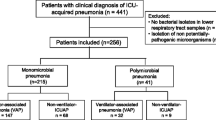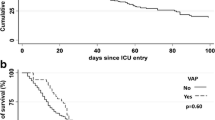Abstract
Loss of protective airway reflexes in patients with acute coma puts these patients at risk of aspiration pneumonia complicating the course of the primary disease. Available data vary considerably with regard to bacteriology, role of anaerobic bacteria, and antibiotic treatment. Our objective was to research the bacteriology of aspiration pneumonia in acute coma patients who were not pre-treated with antibiotics or hospitalized within 30 days prior to the event. We prospectively analyzed 127 patient records from adult patients admitted, intubated and ventilated to a tertiary medical intensive care unit with acute coma. Bacteriology and antibiotic resistance testing from tracheal aspirate sampled within 24 h after admission, blood cultures, ICU scores (APACHE II, SOFA), hematology, and clinical chemistry were assessed. Patients were followed up until death or hospital discharge. The majority of patients with acute coma suffered from acute cardiovascular disorders, predominantly myocardial infarction, followed by poisonings, and coma of unknown cause. In a majority of our patients, microaspiration resulted in overt infection. Most frequently S. aureus, H. influenzae, and S. pneumoniae were isolated. Anaerobic bacteria (Bacteroides spec., Fusobacteria, Prevotella spec.) were isolated from tracheal aspirate in a minority of patients, and predominantly as part of a mixed infection. Antibiotic monotherapy with a 2nd generation cephalosporin, or a 3rd generation gyrase inhibitor, was most effective in our patients regardless of the presence of anaerobic bacteria.


Similar content being viewed by others
References
Marik PE (2001) Aspiration pneumonitis and aspiration pneumonia. N Engl J Med 344:665–671. doi:10.1056/NEJM200103013440908
Marik PE (2011) Pulmonary aspiration syndromes. Curr Opin Pulm Med 17:148–154. doi:10.1097/MCP.0b013e32834397d6
Young GB (2009) Coma. Ann N Y Acad Sci 1157:32–47. doi:10.1111/j.1749-6632.2009.04471.x
Stevens RD, Nyquist PA (2006) Coma, delirium, and cognitive dysfunction in critical illness. Crit Care Clin 22:787–804. doi:10.1016/j.ccc.2006.11.006
Mendelson CL (1946) The aspiration of stomach contents into the lungs during obstetric anesthesia. Am J Obstet Gynecol 52:191–205
Van Westerloo DJ, Knapp S, van’t Veer C et al (2005) Aspiration pneumonitis primes the host for an exaggerated inflammatory response during pneumonia. Crit Care Med 33:1770–1778
Rotta AT, Shiley KT, Davidson BA et al (2004) Gastric acid and particulate aspiration injury inhibits pulmonary bacterial clearance. Crit Care Med 32:747–754
Mandell LA, Wunderink RG, Anzueto A et al (2007) Infectious Diseases Society of America/American Thoracic Society consensus guidelines on the management of community-acquired pneumonia in adults. Clin Infect Dis 44(Suppl 2):S27–S72. doi:10.1086/511159
Lim WS, Baudouin SV, George RC, George RC et al (2009) BTS guidelines for the management of community acquired pneumonia in adults: update 2009. Thorax 64 Suppl 3:1–55. doi:10.1136/thx.2009.121434
Höffken G, Lorenz J, Kern W et al (2010) Guidelines of the Paul-Ehrlich-Society of Chemotherapy, the German Respiratory Diseases Society, the German Infectious Diseases Society and of the competence network CAPNETZ for the management of lower respiratory tract infections and community-acquired pneumonia. Pneumologie 64:149–154. doi:10.1055/s-0029-1243910
Wei C, Cheng Z, Zhang L, Yang J (2013) Microbiology and prognostic factors of hospital- and community-acquired aspiration pneumonia in respiratory intensive care unit. Am J Infect Control 41:880–884. doi:10.1016/j.ajic.2013.01.007
Goldstein EJC, Bartlett JG (2012) Anaerobic bacterial infection of the lung. Anaerobe 18:235–239
Bartlett JG (2013) How important are anaerobic bacteria in aspiration pneumonia: when should they be treated and what is optimal therapy. Infect Dis Clin North Am 27:149–155. doi:10.1016/j.idc.2012.11.016
Johanson WG, Harris GD (1980) Aspiration pneumonia, anaerobic infections, and lung abscess. Med Clin North Am 64:385–394
Mier L, Dreyfuss D, Darchy B et al (1993) Is penicillin G an adequate initial treatment for aspiration pneumonia? A prospective evaluation using a protected specimen brush and quantitative cultures. Intensive Care Med 19:279–284
Self WH, Courtney DM, McNaughton CD et al (2013) High discordance of chest X-ray and computed tomography for detection of pulmonary opacities in ED patients: implications for diagnosing pneumonia. Am J Emerg Med 31:401–405. doi:10.1016/j.ajem.2012.08.041
Anzueto A, Niederman MS, Pearle J et al (2006) Community-acquired pneumonia recovery in the elderly (CAPRIE): efficacy and safety of Moxifloxacin therapy versus that of Levofloxacin therapy. Clin Infect Dis 42:73–81. doi:10.1086/498520
Lipsitch M, Samore MH (2002) Antimicrobial use and antimicrobial resistance: a population perspective. Emerg Infect Dis 8:347–354. doi:10.3201/eid0804.010312
Garnacho-Montero J, García-Cabrera E, Diaz-Martín A et al (2010) Determinants of outcome in patients with bacteraemic pneumococcal pneumonia: importance of early adequate treatment. Scand J Infect Dis 42:185–192. doi:10.3109/00365540903418522
Kumar A, Roberts D, Wood KE et al (2006) Duration of hypotension before initiation of effective antimicrobial therapy is the critical determinant of survival in human septic shock. Crit Care Med 34:1589–1596. doi:10.1097/01.CCM.0000217961.75225.E9
Sauaia A, Moore FA, Moore EE et al (1993) Diagnosing pneumonia in mechanically ventilated trauma patients: endotracheal aspirate versus bronchoalveolar lavage. J Trauma 35:512–517
Schreiber T, Heroldt J, Gottschall R, Klein U (1998) Value of aspiration of tracheal secretions and bronchoalveolar lavage in diagnosis of nosocomial pneumonia in ventilated patients. Anaesthesiol Reanim 23:93–98
Laver S, Farrow C, Turner D, Nolan J (2004) Mode of death after admission to an intensive care unit following cardiac arrest. Intensive Care Med 30:2126–2128. doi:10.1007/s00134-004-2425-z
Lemiale V, Dumas F, Mongardon N et al (2013) Intensive care unit mortality after cardiac arrest: the relative contribution of shock and brain injury in a large cohort. Intensive Care Med 39:1972–1980. doi:10.1007/s00134-013-3043-4
Mongardon N, Dumas F, Ricome S et al (2011) Postcardiac arrest syndrome: from immediate resuscitation to long-term outcome. Ann Intensive Care 1:45. doi:10.1186/2110-5820-1-45
Woo J-H, Lim YS, Yang HJ et al (2013) Factors associated with pneumonia in post-cardiac arrest patients receiving therapeutic hypothermia. Am J Emerg Med. doi:10.1016/j.ajem.2013.10.035
Nielsen N, Wetterslev J, Cronberg T et al (2013) Targeted temperature management at 33 °C versus 36 °C after cardiac arrest. N Engl J Med 369:2197–2206. doi:10.1056/NEJMoa1310519
Geurts M, Macleod MR, Kollmar R et al (2014) Therapeutic hypothermia and the risk of infection: a systematic review and meta-analysis. Crit Care Med 42:231–242. doi:10.1097/CCM.0b013e3182a276e8
Perlino CA (1981) Metronidazole vs clindamycin treatment of anerobic pulmonary infection. Failure of metronidazole therapy. Arch Intern Med 141:1424–1427
Sanders CV, Hanna BJ, Lewis AC (1979) Metronidazole in the treatment of anaerobic infections. Am Rev Respir Dis 120:337–343
Marik PE, Careau P (1999) The role of anaerobes in patients with ventilator-associated pneumonia and aspiration pneumonia: a prospective study. Chest 115:178–183
Sarna JR, Furtado S, Brownell AKW (2013) Neurologic complications of metronidazole. Can J Neurol Sci 40:768–776
Kim DW, Park J-M, Yoon B-W et al (2004) Metronidazole-induced encephalopathy. J Neurol Sci 224:107–111. doi:10.1016/j.jns.2004.06.012
Meersseman W, Lagrou K, Spriet I et al (2009) Significance of the isolation of Candida species from airway samples in critically ill patients: a prospective, autopsy study. Intensive Care Med 35:1526–1531. doi:10.1007/s00134-009-1482-8
Conflict of interest
The authors declare that they have no conflict of interest.
Author information
Authors and Affiliations
Corresponding author
Additional information
E. Lauterbach and F. Voss contributed equally to this work. The manuscript contains data from the doctoral thesis of R. Gerigk.
Rights and permissions
About this article
Cite this article
Lauterbach, E., Voss, F., Gerigk, R. et al. Bacteriology of aspiration pneumonia in patients with acute coma. Intern Emerg Med 9, 879–885 (2014). https://doi.org/10.1007/s11739-014-1120-5
Received:
Accepted:
Published:
Issue Date:
DOI: https://doi.org/10.1007/s11739-014-1120-5




